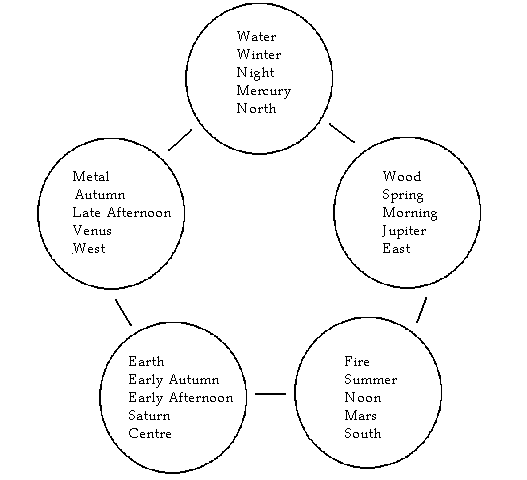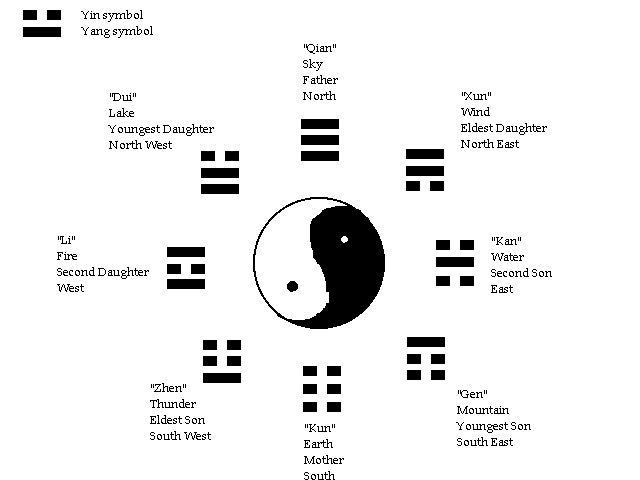
A former professor of architecture of Qinghua university (China's top technical university) was visiting a friend, whose multi-national Chinese company had recently moved office. As soon as he saw his friend's north-facing office window, the professor gasped in horror. "You ought to have that bricked over," he instantly advised, "it attracts bad qi ." The company chairman, astonished by this outlandish suggestion, ignored it. A few unlucky years later however, he called in a Hong Kong fengshui (or geomancy) expert to look over his premises. And the first recommendation… was to have the chairman's window bricked over.
This light-hearted example shows that the Chinese occult universe is not locked away in the past. It is a system of often practical ideas prevalent to varying degrees in all contemporary Chinese communities, which is gaining increasing currency in the West. From the lunar calendar to fengshui to homoepathic medicine, the term "occult universe" refers to a complex scientific system developed in China from the third millenium BC to explain the workings of the universe. Its significance in determining the development of subsequent Chinese philosophies, from Mohism to Daoism to Imperialism is paramount.
The Occult Universe
Between the 22nd and 12th centuries BC, Chinese thought was integrated into a robust system of cosmological and political significance. Incorporated within this were the six classes of occult arts, more specifically (1) astrology, (2) almanacs, (3) the five elements, (4) divination by stalks, (5) other methods of divination and (6) the system of forms (which includes physiognomy and fengshui or geomancy). The basic building blocks for this elaborate system were the Five Elements, which were thought to make up the universe, namely Water, Fire, Wood, Metal and Earth. Each of these five base elements was grouped with physical phenomena, which they were thought to influence, thus creating five different sets of forces or powers, termed the Five Powers.Hence the element Fire, whose basic attribute is heat, was grouped with the direction South, the daily time of high noon and the season of summer. Using the same approach, the four elements Fire & Water and Wood & Metal were grouped with similar physical phenomena and categorised into opposing sets of dynamically interactive Powers. The fifth element, Earth or soil, was incorporated within this schema, somewhat uncomfortably, to make up the Fifth of the Five Powers.
The Five Powers

Since the Ancients assumed that nature responded to the actions of humans, the interaction of the Five Powers was explained in such a way as to relate changes in time and space to human conduct. Thus a relationship was established between the conduct of nature and that of humankind. This is clearly illustrated in The Book of Rites , chapter 4:
"In the first month of spring the east wind resolves the cold. Creatures that have been torpid during the winter begin to move.. All plants bud and grow. The sovereign charges his assistants to disseminate lessons of virtue and harmonise governmental order. Prohibitions are given against cutting down trees. [because wood is the symbol of spring] In this month no warlike operations should be undertaken; such an undertaking is sure to be followed by calamities of heaven (ie natural disasters)."
The Emperor's actions therefore directly affected the course of nature. And it was as a direct result of this symbiotic relationship between the Emperor and Nature that Imperial rule was legitimised in the eyes of the people. This is why the Chinese Emperor's official title was "Emperor through the Mandate of Heaven and in accordance with the movements of the Five Powers."
Establishment of the Confucianist Model
The above format, was combined with the (1) theory of yin and yang and (2) the doctrine of the mean, so that by the 12th century BC King Wen could symbolically represent the pattern of change within the universe in his famous work, the Yi Jing or Book of Changes . This was the cosmological model that Confucius inherited and elaborated with moral significance.
1) The theory of Yin and Yang:
Yang originally meant sunshine and Yin darkness or shadow. Soon, though, they came to refer to two opposing yet complementary cosmic forces. Yang is the universal, masculine principle that denotes the vigorous, bright, hot, dry, hard and active, while Yin is the feminine principle that inspires the passive, docile, cold, dark, wet and gentle. It is the intercourse of these two forces or principles that not only produces all things, but also governs all processes of change.
According to the beliefs underpinning the Book of Changes everything in the universe has a universal principle which defines it. Thus, for example, all walls must correspond to certain specifications to be classified as such; a wall must be upright, solid and thin, otherwise it isn't a wall. In the same way, houses, vehicles and seasons are defined by universal principles. And the same is true for sons, wives, kings and farmers. They all conform to defining, universal principles.
It is then alleged that each of these principles contain and react to different measures of Yin and Yang, depending on circumstance. For example, when a minister talks to a sovereign he should be amenable and passive – a yin characteristic. Yet when, in ancient China, that minister returns home and talks to his family members he should behave in a decisive and firm manner – characteristics of yang. Thus the same thing or person can respond to the prevalent cosmic forces of Yin and Yang in different ways depending on time and circumstance.
Further, the Book of Changes assumes that the general movement of a body or idea or emotion between Yin and Yang is described by the concept of reversal. And so Lao Zi, the Daoist founder who promotes this concept, writes "reversal is the movement of the Power." This means, for example, that the movement of the sun to its zenith (associated with yang) precipitates its reverse movement to the nadir (associated with yin). Similarly, the excessive heat of summer (yang) brings about a reverse movement in the opposite direction to lead us towards winter (yin). Or else in terms of Chinese history, China's continuing fluctuations between political unification (yin) and fragmentation (yang) could be said to evidence this law. Thus every class of thing fluctuates between yin and yang polar opposites about a mean.
2) The Doctrine of the timely, ordinary mean:
This teaching claims that for harmony (the mean) to be ensured every process should happen at a time and in a way proper and fit for it to occur. Thus, winter should begin in December, babies should talk after two years and relatively young people should get married. If events happen in such a way as to conform to a natural sequence, then harmony will prevail and the events, incorporated within this harmonic order, will stand a better chance of being propitious.
In the 12th century BC the laws of the occult system, the theory of yin and yang and the law of the timely mean were synthesised into a complete cosmological and metaphysical system, which is symbolically represented in the Book of Changes .
The Book of Changes
The Book of Changes is comprised of a logically developing series of 64 images mapping every possible yin yang change process. Since every physical and abstract element of reality is susceptible to each of these defined change processes, the whole universe, past, present and future can be viewed through their images.
You use the book of changes like this: you go to a practitioner to inquire about an important event in your life. The practitioner, after a long procedure of yarrow stalk selection, will tell you which of the 64 change processes is controlling your particular event. She will show you its image, or "hexagram", and then will describe the usual characteristics of this change process in your circumstance, informing you how best to act (in accordance with the doctrine of the mean) in order to ensure the propitious completion of the event.
The images in the Book of Changes are called hexagrams, so called because they are made up of six lines. However, it is more correct to think of each hexagram as composed of two trigrams, one on top of the other, each of which is made up of three lines. There are in all 8 trigrams, and by combining each trigram with the other (8 x 8) you get the 64 images or hexagrams that make up the Book of Changes . Each trigram is made up of a combination of three undivided (yang) or divided (yin) lines. And, in the manner of the Five Powers, each trigram is associated with a variety of physical forces to form the visual representation of an interactively linked, dynamic universe. The fundamental visual concepts are expressed in the following popular schema. At the centre are the black and white Yin Yang fish, simultaneously combining to make a whole, flowing into one another to represent the endless process of change. Around this are each of the eight trigrams, placed in such a way as to correspond to their natural compass points.

When you read about Confucianism or Daoism, you will see how the main concepts of the Book of Changes are to be found at the root of much Chinese thought..